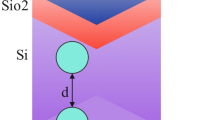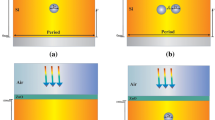Abstract
The use of conical-shaped plasmonic nanostructures for light management in an ultra-thin silicon solar cell has been investigated. The optical absorption and hence photocurrent are obtained for several cases of structures using finite difference time domain simulations. In this paper, we demonstrate that the use of superposition theorem causes significant photocurrent enhancement due to the surface plasmonic effects of nanoparticles. For this, at first, we used one conical-shaped nanoparticle at the top side, then in the rear side, and finally, three nanoparticles are used in the top, bottom, and middle sides. Depending on the incident light wavelength, each nanoparticle manipulates the part of the spectrum. The photocurrents of 9.165, 10.463, 16.402, 17.761, and 18.072 mA/cm2, are obtained for a cell without nanoparticles, with one conical-shaped NP at the top, with one conical-shaped NP at the bottom, with two NPs at top and bottom and with three NPs at the top, bottom, and middle, respectively. Finally, the electrical field distribution and generation rate are calculated for proposed structures.











Similar content being viewed by others
References
Abdel-Latif, G.Y., Hameed, M.F.O., Hussein, M., Razzak, M.A., Obayya, S.S.: Characteristics of highly efficient star-shaped nanowires solar cell. J. Photonics Energy 8(4), 117–131 (2018)
Akimov, Y.A., Koh, W.S.: Design of plasmonic nanoparticles for efficient subwavelength light trapping in thin-film solar cells. Plasmonics 6(1), 155–161 (2011)
Akimov, Y.A., Ostrikov, K., Li, E.: Surface plasmon enhancement of optical absorption in thin-film silicon solar cells. Plasmonics 4(2), 107–113 (2009)
Armaroli, N., Balzani, V.: The future of energy supply: challenges and opportunities. Angew. Chem. Int. Ed. 46(1–2), 52–66 (2007)
Atwater, H.A., Polman, A.: Plasmonics for improved photovoltaic devices. Nat. Mater. 9(3), 205–213 (2010)
Catchpole, K.A., Polman, A.: Plasmonic solar cells. Opt. Express 16(26), 21793–21800 (2008)
Chu, S., Majumdar, A.: Opportunities and challenges for a sustainable energy future. Nature 488(7411), 294–303 (2012)
Deng, C., Tan, X., Jiang, L., Tu, Y., Ye, M., Yi, Y.: Efficient light trapping in silicon inclined nanohole arrays for photovoltaic applications. Opt. Commun. 407, 199–203 (2018)
Enrichi, F., Quandt, A., Righini, G.C.: Plasmonic enhanced solar cells: summary of possible strategies and recent results. Renew. Sustain. Energy Rev. 82, 2433–2439 (2018)
Gedney, S.D.: Introduction to the finite-difference time-domain (FDTD) method for electromagnetics. Synth. Lect. Comput. Electromagn. 6(1), 1–250 (2011)
Green, M.A.: Crystalline and thin-film silicon solar cells: state of the art and future potential. Sol. Energy 74(3), 181–192 (2003)
Green, M.A., Hishikawa, Y., Dunlop, E.D., Levi, D.H., Hohl-Ebinger, J., Ho-Baillie, A.W.: Solar cell efficiency tables (version 52). Prog. Photovolt. Res. Appl. 26(7), 427–436 (2018)
Hamblin, M., Downing, T., Anderson, S., Hawkins, A., Schmidt, H.: A patternable, anti-reflective light blocking layer using a nano-particle suspension in photoresist. In: 2018 IEEE Photonics Conference (IPC), pp. 1–2. IEEE (2018)
Heidarzadeh, H.: Comprehensive investigation of core-shell dimer nanoparticles size, distance and thicknesses on performance of a hybrid organic-inorganic halide perovskite solar cell. Mater. Res. Express 5(3), 1–13 (2018)
Heidarzadeh, H.: Performance analysis of an HJ-IBC silicon solar cell in ultra-high temperatures: possibility of lower reduction efficiency rate. Silicon 12(6), 1369–1377 (2019)
Heidarzadeh, H., Mehrfar, F.: Effect of size non-uniformity on performance of a plasmonic perovskite solar cell: an array of embedded plasmonic nanoparticles with the Gaussian distribution radiuses. Plasmonics 13, 2305–2312 (2018)
Heidarzadeh, H., Tavousi, A.: Performance enhancement methods of an ultra-thin silicon solar cell using different shapes of back grating and angle of incidence light. Mater. Sci. Eng. B 240, 1–6 (2019)
Heidarzadeh, H., Baghban, H., Rasooli, H., Dolatyari, M., Rostami, A.: A new proposal for Si tandem solar cell: significant efficiency enhancement in 3C–SiC/Si. Opt. Int. J. Light Electron Opt. 125(3), 1292–1296 (2014)
Heidarzadeh, H., Dolatyari, M., Rostami, G., Rostami, A.: Modeling of solar cell efficiency improvement using pyramid grating in single junction silicon solar cell. In: 2nd international congress on energy efficiency and energy related materials (ENEFM2014), pp. 61–67. Springer (2015a)
Heidarzadeh, H., Rostami, A., Matloub, S., Dolatyari, M., Rostami, G.: Analysis of the light trapping effect on the performance of silicon-based solar cells: absorption enhancement. Appl. Opt. 54(12), 3591–3601 (2015b)
Heidarzadeh, H., Rostami, A., Dolatyari, M.: Management of losses (thermalization-transmission) in the Si-QDs inside 3C–SiC to design an ultra-high-efficiency solar cell. Mater. Sci. Semicond. Process. 109, 1–9 (2020)
Hussain, S.Q., Le, A.H.T., Mallem, K., Park, H., Ju, M., Lee, S., Cho, J., Lee, Y., Park, J., Cho, E.-C.: Efficient light trapping for maskless large area randomly textured glass structures with various haze ratios in silicon thin film solar cells. Sol. Energy 173, 1173–1180 (2018)
Isabella, O., Vismara, R., Linssen, D., Wang, K., Fan, S., Zeman, M.: Advanced light trapping scheme in decoupled front and rear textured thin-film silicon solar cells. Sol. Energy 162, 344–356 (2018)
Janfaza, M., Mansouri-Birjandi, M.A., Tavousi, A.: Tunable plasmon-induced reflection based on graphene nanoribbon Fabry-Perot resonator and nanodisks. Opt. Mater. 84, 675–680 (2018)
Jang, Y.H., Jang, Y.J., Kim, S., Quan, L.N., Chung, K., Kim, D.H.: Plasmonic solar cells: from rational design to mechanism overview. Chem. Rev. 116(24), 14982–15034 (2016)
Jangjoy, A., Bahador, H., Heidarzadeh, H.: Design of an ultra-thin silicon solar cell using localized surface plasmonic effects of embedded paired nanoparticles. Opt. Commun. 450, 216–221 (2019)
Krogman, K.C., Druffel, T., Sunkara, M.K.: Anti-reflective optical coatings incorporating nanoparticles. Nanotechnology 16(7), 338–343 (2005)
Kunz, K.S., Luebbers, R.J.: The Finite Difference Time Domain Method for Electromagnetics. CRC Press, Boca Raton (1993)
Lozano, G., Louwers, D.J., Rodríguez, S.R., Murai, S., Jansen, O.T., Verschuuren, M.A., Rivas, J.G.: Plasmonics for solid-state lighting: enhanced excitation and directional emission of highly efficient light sources. Light Sci. Appl. 2(5), 66–73 (2013)
Maier, S.A.: Plasmonics: Fundamentals and Applications. Springer, Berlin (2007)
Mandal, P., Sharma, S.: Progress in plasmonic solar cell efficiency improvement: a status review. Renew. Sustain. Energy Rev. 65, 537–552 (2016)
Mokari, G., Heidarzadeh, H.: Efficiency enhancement of an ultra-thin silicon solar cell using plasmonic coupled core-shell nanoparticles. Plasmonics 14, 1–9 (2019)
Morawiec, S., Mendes, M., Priolo, F., Crupi, I.: Plasmonic nanostructures for light trapping in thin-film solar cells. Mater. Sci. Semicond. Process. 92, 10–18 (2018)
Nagel, J.R., Scarpulla, M.A.: Enhanced absorption in optically thin solar cells by scattering from embedded dielectric nanoparticles. Opt. Express 18(102), A139–A146 (2010)
Nasser, H., Saleh, Z.M., Özkol, E., Günoven, M., Bek, A., Turan, R.: Fabrication of Ag nanoparticles embedded in Al: ZnO as potential light-trapping plasmonic interface for thin film solar cells. Plasmonics 8(3), 1485–1492 (2013)
Oulton, R.F., Sorger, V.J., Genov, D., Pile, D., Zhang, X.: A hybrid plasmonic waveguide for subwavelength confinement and long-range propagation. Nat. Photonics 2(8), 496–500 (2008)
Pala, R.A., White, J., Barnard, E., Liu, J., Brongersma, M.L.: Design of plasmonic thin-film solar cells with broadband absorption enhancements. Adv. Mater. 21(34), 3504–3509 (2009)
Pillai, S., Catchpole, K., Trupke, T., Green, M.: Surface plasmon enhanced silicon solar cells. J. Appl. Phys. 101(9), 1–9 (2007)
Reineck, P., Lee, G.P., Brick, D., Karg, M., Mulvaney, P., Bach, U.: A solid-state plasmonic solar cell via metal nanoparticle self-assembly. Adv. Mater. 24(35), 4750–4755 (2012)
Shah, A., Torres, P., Tscharner, R., Wyrsch, N., Keppner, H.: Photovoltaic technology: the case for thin-film solar cells. Science 285(5428), 692–698 (1999)
Sheng, X., Broderick, L.Z., Kimerling, L.C.: Photonic crystal structures for light trapping in thin-film Si solar cells: modeling, process and optimizations. Opt. Commun. 314, 41–47 (2014)
Shim, J.-P., Choi, S.-B., Kong, D.-J., Seo, D.-J., Kim, H.-J., Lee, D.-S.: Ag nanoparticles-embedded surface plasmonic InGaN-based solar cells via scattering and localized field enhancement. Opt. Express 24(14), A1176–A1187 (2016)
Sönnichsen, C.: Plasmons in metal nanostructures. PhD diss., 1-134 LMU (2001)
Spinelli, P., Ferry, V., Van de Groep, J., Van Lare, M., Verschuuren, M., Schropp, R., Atwater, H., Polman, A.: Plasmonic light trapping in thin-film Si solar cells. J. Opt. 14(2), 344–356 (2012)
Tan, H., Santbergen, R., Smets, A.H., Zeman, M.: Plasmonic light trapping in thin-film silicon solar cells with improved self-assembled silver nanoparticles. Nano Lett. 12(8), 4070–4076 (2012)
Xia, D., Hu, L., Tan, X., He, C., Pan, W., Yang, T., Huang, Y., Shu, D.: Immobilization of self-stabilized plasmonic Ag-AgI on mesoporous Al2O3 for efficient purification of industrial waste gas with indoor LED illumination. Appl. Catal. B 185, 295–306 (2016)
Yang, M., Fu, Z., Lin, F., Zhu, X.: Incident angle dependence of absorption enhancement in plasmonic solar cells. Opt. Express 19(104), A763–A771 (2011)
Zhang, J.Z.: Biomedical applications of shape-controlled plasmonic nanostructures: a case study of hollow gold nanospheres for photothermal ablation therapy of cancer. J. Phys. Chem. Lett. 1(4), 686–695 (2010)
Author information
Authors and Affiliations
Corresponding author
Additional information
Publisher's Note
Springer Nature remains neutral with regard to jurisdictional claims in published maps and institutional affiliations.
Rights and permissions
About this article
Cite this article
Sobhani, F., Heidarzadeh, H. & Bahador, H. Efficiency enhancement of an ultra-thin film silicon solar cell using conical-shaped nanoparticles: similar to superposition (top, middle, and bottom). Opt Quant Electron 52, 387 (2020). https://doi.org/10.1007/s11082-020-02487-2
Received:
Accepted:
Published:
DOI: https://doi.org/10.1007/s11082-020-02487-2




